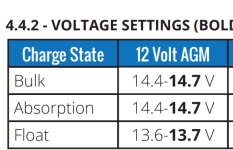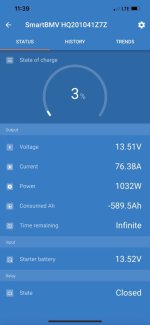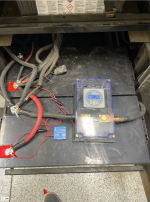- Thread starter
- #21
EmpirE231
Well-known member
- Aug 12, 2021
- 700
- 558
Okay here is what fullriver wants for a charge profile
Which according to fullriver... a magnum inverter should be set to AGM 2 battery type (which both currently are)
from what I have read, each charger is capable of charging @ 100 amps.

per the fullriver manual... total charging current can be:
All Models (excl. FSG): The recommended bulk current is 20-25% of the 20 Hr AH capacity or 0.20 x C20 (20 Hr. capacity in AH). The maximum allowable bulk current is 35% of the 20 Hr. AH capacity or 0.35 x C20 (20Hr. capacity in AH), unless specified.
So.... I have a total of 896 AH (if I did my math right), so according to their formula... I can push 180 amps to 224 amps
and then what they recommend for absorption time is:
Absorption time varies per installation according to total bank size and total PV kW. Our maximum absorption time is 4 hours, however most installations need 2-3 hours on average. To estimate your rough absorption time, use the following formula: [(AH * DOD) / CHARGE AMPS * 0.85]
I have no idea what DOD means in that formula... so maybe someone can help there. But currently both chargers were set at 3.5Hr absorption time... and they were set at 80%, most likely meaning only 80 amps per charger.... and the other thing to keep in mind, is both of those going while plugged into a regular 15amp outlet were tripping breakers.... so I have no idea if this was all the proper setting to get these batteries to 100% charge level.
with all this info given... what should my charge amps and absorption time be set at? and keep in mind there are 2 chargers... so do I split it between the two?
first thing I need to figure out before deciding if the batteries are bad, is if these are even being charged to 100%
Which according to fullriver... a magnum inverter should be set to AGM 2 battery type (which both currently are)
from what I have read, each charger is capable of charging @ 100 amps.

per the fullriver manual... total charging current can be:
All Models (excl. FSG): The recommended bulk current is 20-25% of the 20 Hr AH capacity or 0.20 x C20 (20 Hr. capacity in AH). The maximum allowable bulk current is 35% of the 20 Hr. AH capacity or 0.35 x C20 (20Hr. capacity in AH), unless specified.
So.... I have a total of 896 AH (if I did my math right), so according to their formula... I can push 180 amps to 224 amps
and then what they recommend for absorption time is:
Absorption time varies per installation according to total bank size and total PV kW. Our maximum absorption time is 4 hours, however most installations need 2-3 hours on average. To estimate your rough absorption time, use the following formula: [(AH * DOD) / CHARGE AMPS * 0.85]
I have no idea what DOD means in that formula... so maybe someone can help there. But currently both chargers were set at 3.5Hr absorption time... and they were set at 80%, most likely meaning only 80 amps per charger.... and the other thing to keep in mind, is both of those going while plugged into a regular 15amp outlet were tripping breakers.... so I have no idea if this was all the proper setting to get these batteries to 100% charge level.
with all this info given... what should my charge amps and absorption time be set at? and keep in mind there are 2 chargers... so do I split it between the two?
first thing I need to figure out before deciding if the batteries are bad, is if these are even being charged to 100%



